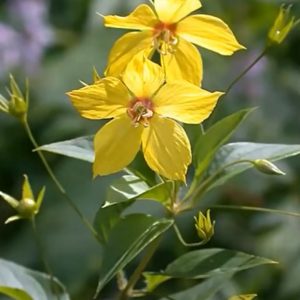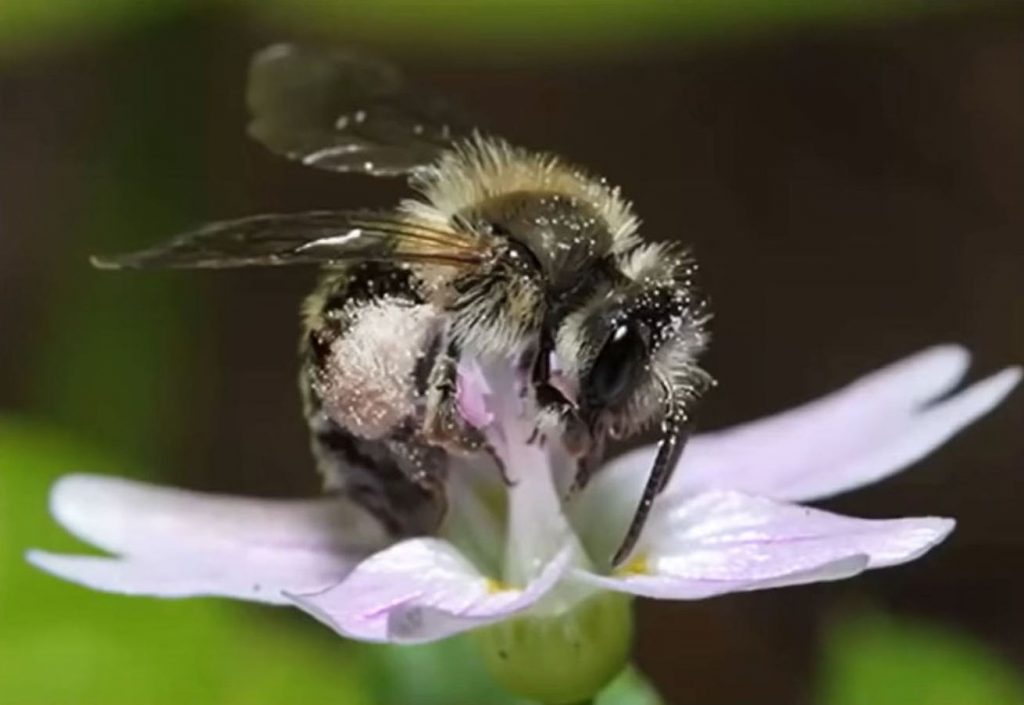by Sandy Garland
with thanks to Lydia Wong, Colleen Smith, Jessica Forrest, and members of the Insects and Arachnids of Ontario Facebook group for providing local information
Until recently, I thought bees were happy to visit any flower that provided the nectar or pollen they were foraging for. However, a webinar in the Tending Nature series presented by Ohio State University revealed, for me, the large number of bees that specialize in a single species, genus, or family of flowers.
Why would they do that? Because it’s very efficient to focus on a single type of flower, especially if there are many. Specialists are all solitary bees. They don’t live very long. Most are ground-nesting.
Specialism pre-dates generalism, so these bees evolved with their flowers. They often have mouth parts especially adapted to reach nectar in their host flower and they are the right size to carry out efficient pollination. Some are so tied to their host plant that in extreme weather conditions, when the host plant doesn’t bloom, its specialist bee doesn’t emerge from its ground nest and can remain dormant for a whole year in hopes of a better next season.
As bees evolved, some were able to “branch out” and become generalists, which would allow them to live longer and in more places. Many, if not most, specialists are of “conservation concern,” very likely because the wildflowers they depend on are disappearing along with the wild spaces in which they thrive. Or, with changes in climate, blooming time may be out of sync with the specialist’s life cycle.
Which bees are specialists? Specialism is widespread across all seven North American bee families. Almost all Melittidae, for example, are specialists, as are most Megachilidae.
Where do they live? Looking at the broad ecosystems of North America, we find the lowest number of specialist bee species in the tundra, but the highest number and the most diversity of species in desert regions. Our eastern deciduous forest region falls in the middle.
How can we help?

Fringed Loosestrife (Lysimachia ciliata), the favoured species of Macropis nuda, which uses oil from these flowers to line its brood cells.
Most guides to creating pollinator gardens focus on generalists, but Cornell University has recently produced Creating a Pollinator Garden for Native Specialist Bees of New York and the Northeast.
Most specialists are ground-nesting, so they need areas of bare soil. If you must mulch, use fall leaves, but leave bare spaces as well.
Add a few rocks and/or logs to your garden to help bees orient.
Rotting, decomposing logs also provide nesting sites for some species.
Leave the dead stems of shrubs and grasses in the fall to prove overwintering sites for young bees and pupae.
But the most important thing you can do for specialist bees is grow the flowers they need – native plants sourced locally.
Heather Holm’s book, Pollinators of Native Plants, notes specialist bees under the flower species they use, so you can look up the native plants you already have in your garden to see if they are needed by a specialist. The Cornell guide also contains a long list of shrubs and wildflowers used by specialists.
However, all this can be pretty overwhelming, so I asked some of Jessica Forrest’s students if they had studied specialists locally. Colleen Smith had and she provided the following.
“I do have a record of the specialist bees we found in Ottawa! We sampled bees from eight species of plants we knew were used by specialists and found pollen specialist bees on all of them: Spring Beauty, Willow, Blueberry, Dogwood, Fringed Loosestrife, Pickerelweed, Squash, and Goldenrod. I’ve attached a list of the pollen specialist species we found, their host plants and how many of the bees we found of each.
| Bee species | Host plant | No. bees found |
| Andrena simplex | Solidago (Goldenrods) | 1 |
| Melissodes niveus | Asteraceae (Asters) | 1 |
| Colletes simulans | Solidago (Goldenrods) | 4 |
| Melissodes druriellus | Asteraceae (Asters) | 4 |
| Andrena bradleyi | Ericaceae (Blueberries) | 5 |
| Andrena frigida | Salix (Willows) | 5 |
| Andrena salictaria | Salix (Willows) | 5 |
| Andrena platyparia | Cornus (Dogwoods) | 6 |
| Perdita octomaculata | Asteraceae (Asters) | 9 |
| Andrena nubecula | Solidago (Goldenrods) | 14 |
| Macropis nuda | Lysimachia (Fringed Loosestrife) | 16 |
| Andrena integra | Cornus (Dogwoods) | 18 |
| Andrena erigeniae | Claytonia (Spring Beauty) | 38 |
| Peponapis pruinosa | Cucurbita (Squash) | 49 |
| Dufourea novaeangliae | Pontederia (Pickerelweed) | 146 |
“It’s hard to say if any of them are endangered, because there’s not a lot of long-term data for most bee genera. Some I am fairly certain are not endangered, e.g., squash bees (Peponapis pruinosa) are extremely common and you find them anywhere squash is growing. Andrena erigeniae (the Spring Beauty specialist) is also very common, although maybe not as common in Ottawa as in other parts of its range. You can get a sense of how common or rare the species are based on how many we collected! I would guess that there are even more pollen specialist bees than those species in Ottawa.”
Lydia Wong, another Ottawa U student and frequent contributor to WPP, recommended Jarrod Fowler’s list of all the specialist bees in the eastern United States. Colleen suggested using this list to identify bees with a more northern range in the eastern U.S. (e.g., listed as occurring in New York or the New England states) and with a host plant that is abundant in Ottawa, as those species are probably found here.
Lydia worked with Eden Gerner, who recently published some of her results from urban gardens in Ottawa. According to Lydia, “Looking at Eden’s list, some of the specialists found in Ottawa are Melissodes agilis, Melissodes trinodis, and Colletes compactus, (all three I think are aster specialists), Chelostoma campanularum, Megachile campanulae (specialists on bellflower family plants like harebells, although C. campanularum is non-native) and Peponapsis pruinosa (specialist on squash-family plants). I think there are likely others not in this list that I imagine could be in Ottawa too including Andrena erigeniae (specialist on Spring Beauty), and maybe Macropis nuda (specialist on Lysimachia family plants).”
Finally, I also appealed to the Insects and Arachnids of Ontario Facebook group, and they added Trout Lilies used by Andrena erythronii and Evening Primrose used by Lasioglossum oenotherae.
Jessica tells me that all the Andrena species observed at the Fletcher Wildlife Garden (see insect list) are generalists. But we’ve planted a bunch of Evening Primrose seeds and we plan to keep a close eye on all our asters and goldenrods this year to see if we can spot a specialist.
If anyone is interested, we could also organize short excursions to look at Fringed Loosestrife at Chapman Mills and Pickerel Weed at Brewer Pond while these species are blooming. Does anyone know where to find Spring Beauty? Blueberries?


I love Spring Beauty flowers and the Andrena bees that pollinate them.
2 local areas where I have seen Claytonia are the Reveler Conservation Area and Stony Swamp.
Claytonia has really spread in our cottage area in the Ompah, Plevna region in recent years.
I grow several different Aster and Solidago species at home so will have to look for these specialist bees this summer.
Thanks for the interesting article.
Hello, you can find blueberries growing at the mer blue bog boardwalk (Orleans/navan area) . I saw an interesting bumble (?) bee yesterday in the gardens near the arboretum/museum of agriculture . It was visiting the irises. It was fuzzy, large and had several stripes on his back/tail part like a wasp would but it was not a wasp. I am not sure what kind it was because it looks different and had more stripes than other bumble bees.. any ideas what it could be ?